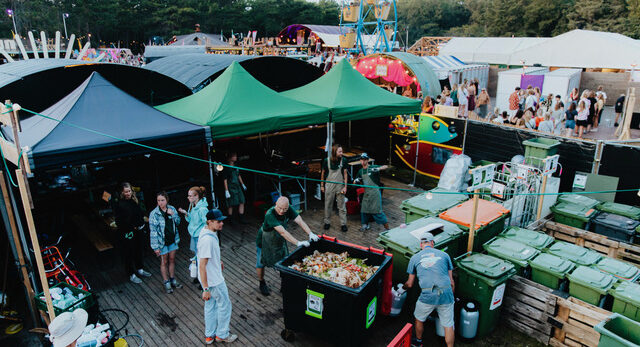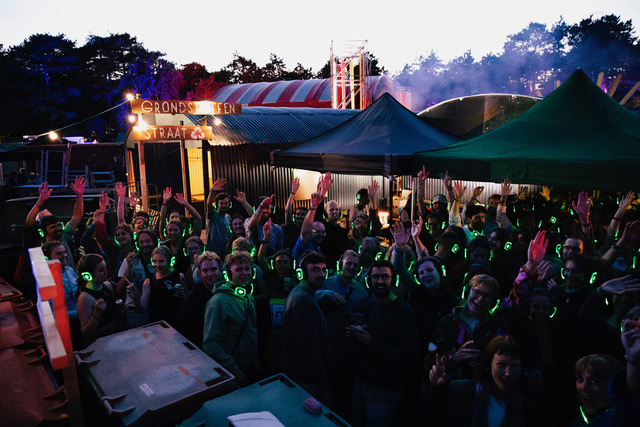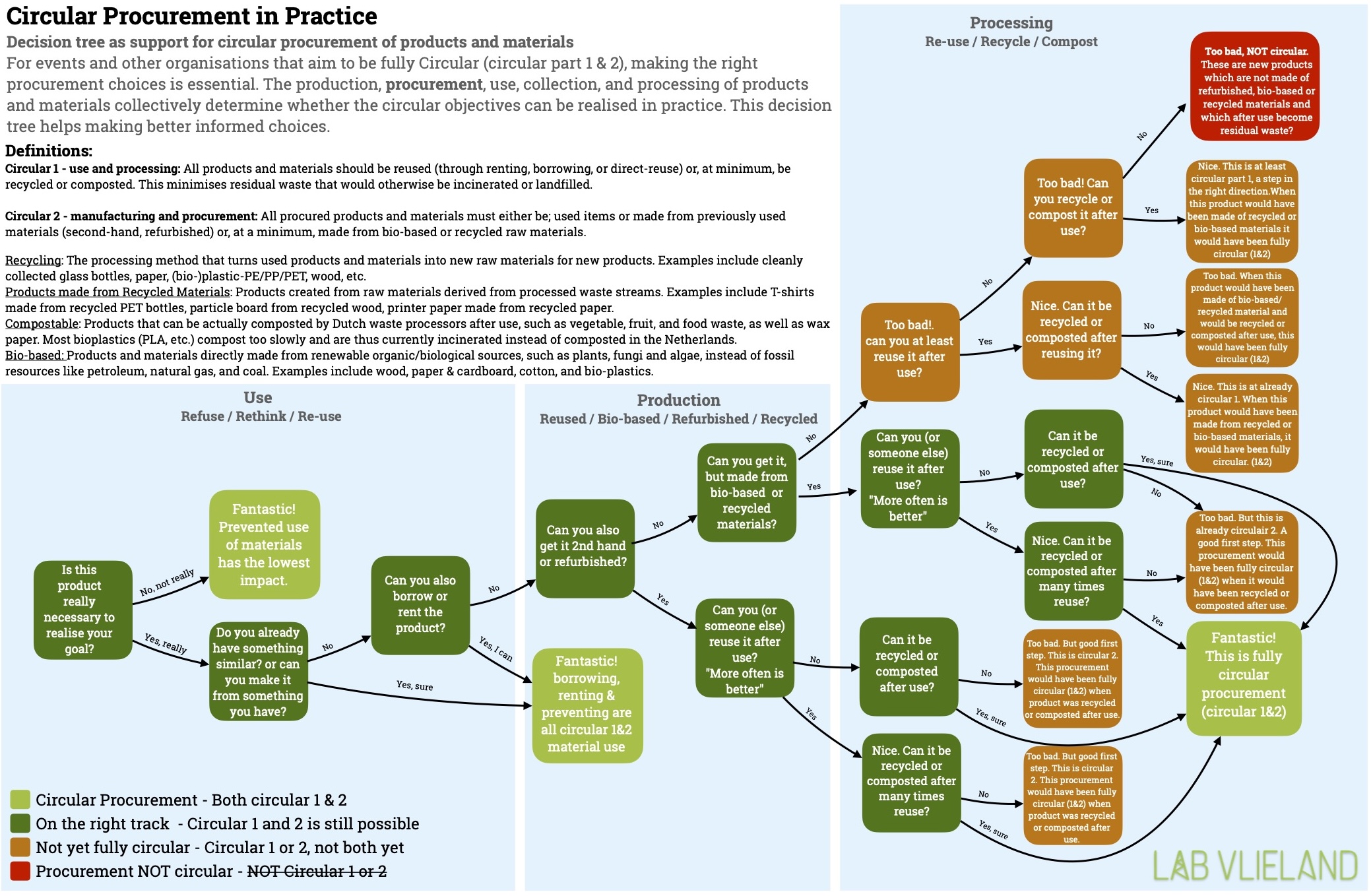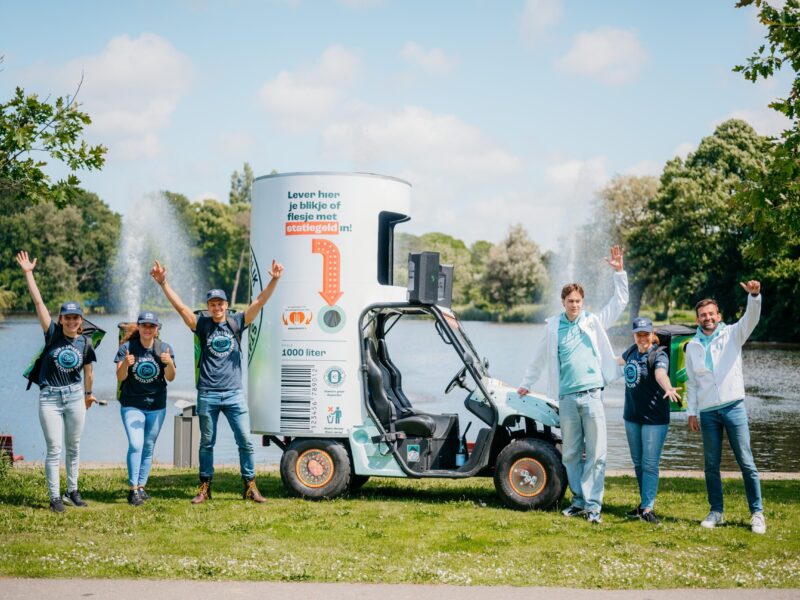
Smarter Sourcing explained: How to buy supplies for a circular festival
This article was originally published via Green Deal Circular Festivals and can be found here.
True circularity starts long before the festival gates open – it begins with what’s procured, sourced, and brought into the organization in the first place. Read how to implement a procurement policy in this article.
Imagine this: behind the fences of a festival, a recycling team is working tirelessly to sort waste into different streams, determined to uphold the event’s sustainability ambitions. While the recycling effort might create an image of circular progress, the reality is clear: what enters the event matters just as much as what leaves it. On the production side, decisions are often being made under pressure — if an item offers a solution, it is purchased to keep things running smoothly. There is little thought about the materials, their long-term impact, or what happens after the festival.
True circularity starts long before the festival gates open – it begins with what’s procured, sourced, and brought into the organization in the first place. To become a circular festival, you need a circular procurement policy.
What Is Circular Procurement?
Procurement is the process of sourcing and purchasing materials or services for an organization. Circular procurement is the practice of purchasing goods and services, focusing on minimising waste and maximising resource efficiency. This means prioritizing reuse, repair, and recycling while ensuring products are used in a long, purposeful lifecycle. Shifting to renewable resources is key: think FSC-certified timber for stages, signage, and furniture; cornstarch or bamboo tableware; cotton wristbands, banners, flags, and merchandise – rather than plastic or other synthetic materials.
Explained: lifecycle
The entire journey of a product from production to disposal, including its use, reuse, and recycling stages. Example: A wooden table used at a festival, later repaired for another event, and finally composted when it’s no longer repairable.
Why does Circular Procurement matter?
If done seriously, circular procurement tackles broader environmental challenges of resource depletion, climate crises, and biodiversity loss. But it also brings about:
- Market shifts: It creates demand for sustainable and circular products, encouraging suppliers to innovate and offer greener solutions or switch to circular business models.
- Resource efficiency: Circular procurement supports resource loops, keeping materials in use for as long as possible and reducing waste.
- Aligned goals: By embedding sustainability into procurement, organizations align their purchasing practices with broader environmental, social, and economic objectives.
Explained: resource loops
Systems where materials are reused, recycled, or remanufactured to keep them in use rather than discarded. Example: Renting reusable plates for food stalls that are washed and used again at future events.
How can I implement a Circular Procurement Policy in my organization?
Building a circular procurement strategy requires commitment, planning, and ongoing evaluation. Here’s how to get started:
- Assess the current situation: Begin by reviewing and reporting on your organization’s procurement practices and those of your supply chain. When, how, and why do materials and products reach their end-of-life?
- Develop a policy: Create a clear circular procurement policy aligned with circular principles, and communicate it to all stakeholders, from internal teams to external service partners.
- Decision-making tools: Use practical frameworks, like ITGWO’s Circular Procurement Decision Tree (explored below), to make informed choices.
- Evaluate and adapt: Regularly measure progress and refine policies, strategies, and tools to meet evolving needs and goals.
Explained: end-of-life
The stage when a product is no longer usable in its current form and decisions are made about disposal, recycling, or repurposing.

Case Study: Development and implementation of the ITGWO’s “Circular Procurement Decision tree
Into the Great Wide Open (ITGWO) offers a compelling example of how to embed circularity into operations and procurement.
Step 1: Tackling Waste Management
Initially, the team focused on the ‘use’ and ‘end-of-life’ phases of the circular process. The festival introduced:
- A backstage resource hub to centralize material management.
- Resource collection points for attendees, replacing traditional separate waste bins.
These efforts significantly reduced residual waste but hit a ceiling—waste separation alone couldn’t achieve the festival’s zero-waste ambitions.
Step 2: Shifting the Lens to Procurement
The team then turned its attention to incoming materials. The team asked: which items were becoming residual waste? From this analysis, a new policy emerged:
- Everything brought to the festival had to be reusable—rented, borrowed, or drawn from the festival’s own reuse inventory.
- If reuse wasn’t feasible or affordable, the next option was items compatible with existing recycling or composting streams.
This shift had an immediate impact:
- In 2022, residual waste dropped to +/-150 grams per visitor per day.
- In 2023, it fell further to +/-100 grams per visitor per day.
- For 2024, the target is +/-50 grams per visitor per day.
While this addressed the use and processing side of the circular model (part 1), ITGWO recognized shortcomings in its circular procurement practices (part 2) as defined by the GDCF.
Step 3: Developing the Circular Procurement Decision Tree
In 2023, ITGWO measured its procurement practices with the GDCF monitor. The findings were clear: only 15% of materials procured were circular, defined as second-hand, bio-based, or recycled. A staggering 85% of purchases were new, made of virgin materials.
Explained: virgin materials
Raw materials that are extracted or harvested from nature and used for the first time, rather than being recycled. Example: Buying new plastic cups made from freshly extracted petroleum instead of using recycled plastic.
To tackle this, ITGWO collaborated with Lab Vlieland to create the Circular Procurement Decision Tree. This tool simplifies decision-making with practical questions about the manufacture, use, and end-of-life of prospective purchases.

The results speak volumes. By starting the conversation within the organisation and embedding the Decision Tree into its procurement policy:
- Circular procurement jumped to 80% in 2024 (preliminary results).
- Only 20% of materials remained non-circular.
Here’s how one team member described their experience with the Circular Procurement Decision Tree: “The Decision Tree made me more aware of what I truly need for a production or festival, and it’s made me more critical of purchasing decisions — even beyond ITGWO. During the festival, I realized how much can be reused from previous years, like information posters that are still relevant, and I’ve become more mindful about what I throw away versus what still has value.”
Actionable Insights
Into the Great Wide Open’s success underscores a critical lesson: becoming circular is more than a waste management effort. Informed, systematic approaches can bring organizations closer to true circularity. It requires rethinking what enters the organization — and aligning procurement practices with sustainability goals. For festivals, events, or any organization aiming to adopt circularity, here’s what you can do:
- Evaluate your current procurement practices.
- Develop a clear circular procurement policy.
- Use tools like the ITGWO decision tree to simplify and improve decision-making.
- Monitor progress and refine your approach.
Circular procurement is a game-changer in the journey toward a sustainable, circular organisation. As Into the Great Wide Open shows, it’s possible to rethink traditional practices and achieve remarkable results.
——–
Are you ready to make the shift? Start with your own procurement policy — and transform your organization from the inside out.






